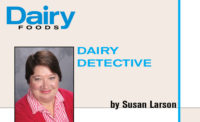Thanks to emerging studies, an ingredient like milkfat that was once taken out of food formulations due to health misconceptions is now getting appreciation. New research on milkfat ingredients and their relation to heart health, obesity and Type 2 diabetes is causing a shift in thinking.
The changing perception
A main reason full-fat dairy products have been viewed negatively by consumers and health professionals is because 65% to 70% of the fat content is saturated fatty acids, which have historically been characterized as detrimental. This level of saturated fat, along with the cholesterol content, resulted in the recommendation to limit milkfat consumption to decrease the risk of cardiovascular disease (CVD) and other chronic diseases.
However, recent research suggests that saturated fat intake may not be directly associated with CVD risk after all. Some studies even state that certain fatty acids found in dairy result in a reduced risk of heart disease. Higher-fat dairy products also were presumably linked to obesity and Type 2 diabetes. Here too, emerging research shows the opposite — higher-fat dairy foods are associated with lower risk of Type 2 diabetes and obesity. A study in young adults found that consumption of high-fat dairy products was linked to reduced risk of both obesity and abnormal blood glucose control.
Even though more research is needed to fully understand the healthfulness of milkfat, this evidence has caused the reassessment of whole- and reduced-fat dairy foods. This improving reputation and preference for cleaner labels are influencing consumers to be more accepting of full-fat dairy products. Now, U.S. milkfat production is projected to grow to 11.5 billion pounds in 2017. From 2018 on, exports on a milkfat basis are expected to continue on an upward trend to 13.6 billion pounds in 2025.
Butter is back
Consumers are beginning to understand that milkfat is a better option than refined vegetable fats and partially hydrogenated oils. Butter is specifically regaining a favorable standing with consumers. They see it as a tastier alternative to partially hydrogenated fats. Foodies see it as the best cooking fat. In 2014, butter consumption reached a 39-year high of 5.5 pounds per person in the United States.
Since butter does not contain the trans-fats that are found in margarines or other hydrogenated fat products, it is a more attractive ingredient. It has already been reintroduced to the foodservice industry by McDonald’s, which is now using real butter in its supply chain. Additional products containing milkfat include cream, half-and-half, evaporated milk, whole milk, sour cream, concentrated milk, dairy powders and anhydrous milkfat (AMF). The functionalities of these ingredients lend themselves to a wide variety of food applications.
The flavor that melts
In formulations, milkfat provides flavor, mouthfeel, texture, lubrication, body and a pleasant aftertaste. It is an excellent carrier for flavor compounds, which release slowly in the mouth, resulting in a long-lasting flavor experience. It also has a unique melt behavior, softening well at body temperature while retaining a solid temperature during refrigeration. This allows a slow release of flavor for an extended tasting period.
Understanding the melting behavior of milkfat is a must when formulating different applications. Fats at colder temperatures (hard fractions) play an important functional role in bakery, like puff pastries, and confectionary because they melt when eaten. Fats at warmer temperatures (low-melt fractions) can be useful in producing cold-spreadable butter. It also is possible to tailor the milkfat for targeted application by blending various fractions. However, choosing the right milkfat ingredient will determine the exact functional characteristics of the finished product.
Fat’s many applications
Cream and butter contain some of the highest levels of moisture, which can limit their use because of shelf-life concerns or the moisture requirements of foods. Ingredients such as AMF, butter oil, butter powders, dry cream and whey protein phospholipid concentrate can be used in almost any product where a fat source is needed, due to their lower moisture content.
Butter powder is easier to use than butter for countries with a tropical climate, which also makes it useful in fluid, ready-to-eat soups, sauces and prepared meals. These applications can utilize milkfat ingredients for clean-label appeal, smooth texture, glossier appearance, thick texture and well-rounded flavor.
Butter and AMF also can act as a flavor carrier for spices, herbs and other fat-soluble ingredients. These formulation benefits skim the surface in what milkfat can do for applications. Eliminate hydrogenated oils and innovate with milkfat as it breaks away from its wrongful reputation.


